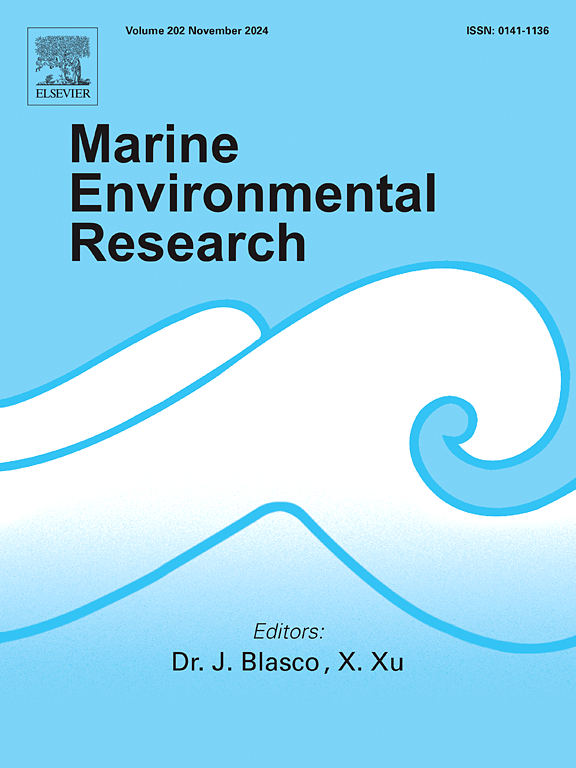The effect of temperature on the photosynthetic carbon fixation efficiency of sessile macroalgae in the mussel farming area of Gouqi Island through stable isotope
IF 3
3区 环境科学与生态学
Q2 ENVIRONMENTAL SCIENCES
引用次数: 0
Abstract
This study aimed to investigate the carbon fixation capacity of macroalgae in the mussel farming area of Gouqi Island and to quantify further the carbon fixation effect during the cultivation process of macroalgae. Using high-abundance Na213CO3 as a tracer combined with stable isotope technology, we quantitatively analyzed the photosynthetic carbon fixation rate, biological carbon sequestration amount, and particulate organic carbon generation rate of three macroalgae species—Ulva pertusa, Sargassum horneri, and Grateloupia turuturu—across a range of temperatures (5 °C, 10 °C, 15 °C, 20 °C, 25 °C, 30 °C). The results showed that Ulva pertusa exhibited the highest photosynthetic carbon fixation rate and carbon sequestration amount, peaking at 25 °C and 20 °C, respectively. Specifically, the photosynthetic carbon fixation rate reached 451.2 ± 21.8 μg C/(g FW·h), and the biological carbon sequestration amount was 235.5 ± 4.2 μg C/(g FW·h). Sargassum horneri followed closely, with a photosynthetic carbon fixation rate of 450.3 ± 28.1 μg C/(g FW·h) at 15 °C and a biological carbon sequestration rate of 189.0 ± 1.8 μg C/(g FW·h) at 25 °C. Grateloupia turuturu exhibited a relatively lower photosynthetic carbon fixation ability, achieving a maximum rate of 290.0 ± 20.4 μg C/(g FW·h) at 20 °C. Ulva pertusa demonstrated broad temperature adaptability and strong carbon sequestration capacity, thriving within a suitable growth temperature range of 15–25 °C. Sargassum horneri maintained a rapid growth rate at 5 °C and exhibited high photosynthetic carbon fixation efficiency at 15 °C. However, high temperatures (≥25 °C) significantly inhibited its photosynthetic activity. In contrast, Grateloupia turuturu showed relatively low photosynthetic and carbon fixation efficiency at high temperatures but had enhanced carbon fixation ability at 15 °C and 20 °C. This study provides quantitative data for evaluating the carbon fixation effects of macroalgae and demonstrates the feasibility of using stable isotope technology to rapidly and accurately determine the carbon sequestration capacity of macroalgae. These findings offer a scientific basis for the accounting of biological carbon sequestration and support the application of macroalgae in achieving carbon neutrality.
通过稳定同位素研究温度对沟岐岛贻贝养殖区无柄大型藻类光合固碳效率的影响
本研究旨在调查沟岐岛贻贝养殖区大型藻类的固碳能力,进一步量化大型藻类在养殖过程中的固碳效应。以高丰度Na213CO3为示踪剂,结合稳定同位素技术,定量分析了3种大型藻类(ulva pertusa、Sargassum horneri和Grateloupia turutura)在5°C、10°C、15°C、20°C、25°C、30°C)下的光合固碳率、生物固碳量和颗粒有机碳生成率。结果表明,紫檀光合固碳速率和固碳量最高,分别在25°C和20°C达到峰值。其中,光合固碳速率为451.2±21.8 μ C/(g FW·h),生物固碳量为235.5±4.2 μ C/(g FW·h)。马尾藻紧随其后,15℃下的光合固碳速率为450.3±28.1 μ C/(g FW·h), 25℃下的生物固碳速率为189.0±1.8 μ C/(g FW·h)。在20°C条件下,光能固碳速率最大为290.0±20.4 μ C/(g FW·h)。紫杉树具有广泛的温度适应性和较强的固碳能力,在15 ~ 25℃的适宜生长温度范围内生长旺盛。马尾藻在5℃下保持了较快的生长速度,在15℃下表现出较高的光合固碳效率。然而,高温(≥25℃)显著抑制其光合活性。而在高温下,Grateloupia turuturu的光合和固碳效率相对较低,但在15°C和20°C时固碳能力增强。本研究为评价大型藻类的固碳效应提供了定量数据,证明了利用稳定同位素技术快速准确测定大型藻类固碳能力的可行性。这些发现为计算生物固碳提供了科学依据,并为大型藻类在实现碳中和中的应用提供了支持。
本文章由计算机程序翻译,如有差异,请以英文原文为准。
求助全文
约1分钟内获得全文
求助全文
来源期刊

Marine environmental research
环境科学-毒理学
CiteScore
5.90
自引率
3.00%
发文量
217
审稿时长
46 days
期刊介绍:
Marine Environmental Research publishes original research papers on chemical, physical, and biological interactions in the oceans and coastal waters. The journal serves as a forum for new information on biology, chemistry, and toxicology and syntheses that advance understanding of marine environmental processes.
Submission of multidisciplinary studies is encouraged. Studies that utilize experimental approaches to clarify the roles of anthropogenic and natural causes of changes in marine ecosystems are especially welcome, as are those studies that represent new developments of a theoretical or conceptual aspect of marine science. All papers published in this journal are reviewed by qualified peers prior to acceptance and publication. Examples of topics considered to be appropriate for the journal include, but are not limited to, the following:
– The extent, persistence, and consequences of change and the recovery from such change in natural marine systems
– The biochemical, physiological, and ecological consequences of contaminants to marine organisms and ecosystems
– The biogeochemistry of naturally occurring and anthropogenic substances
– Models that describe and predict the above processes
– Monitoring studies, to the extent that their results provide new information on functional processes
– Methodological papers describing improved quantitative techniques for the marine sciences.
 求助内容:
求助内容: 应助结果提醒方式:
应助结果提醒方式:


